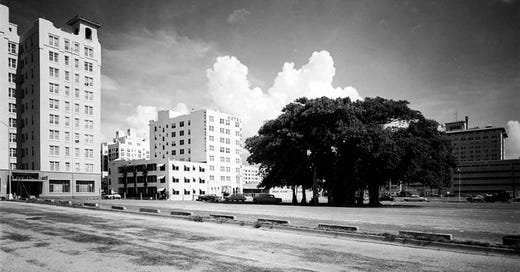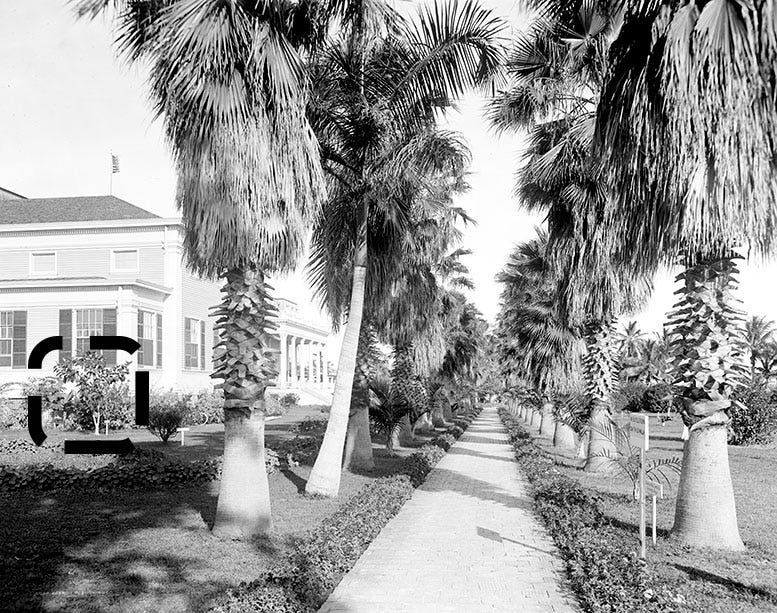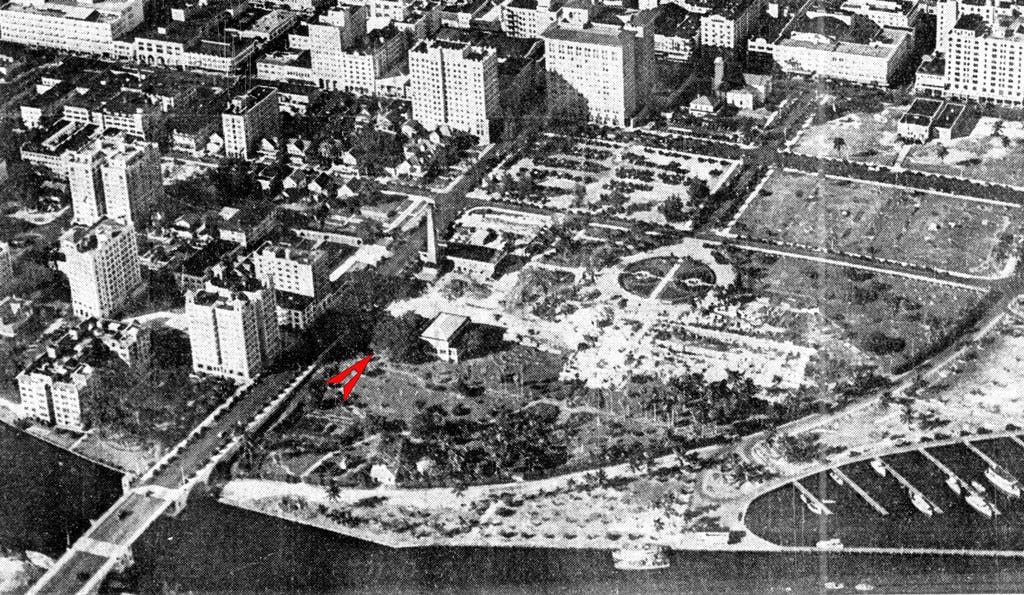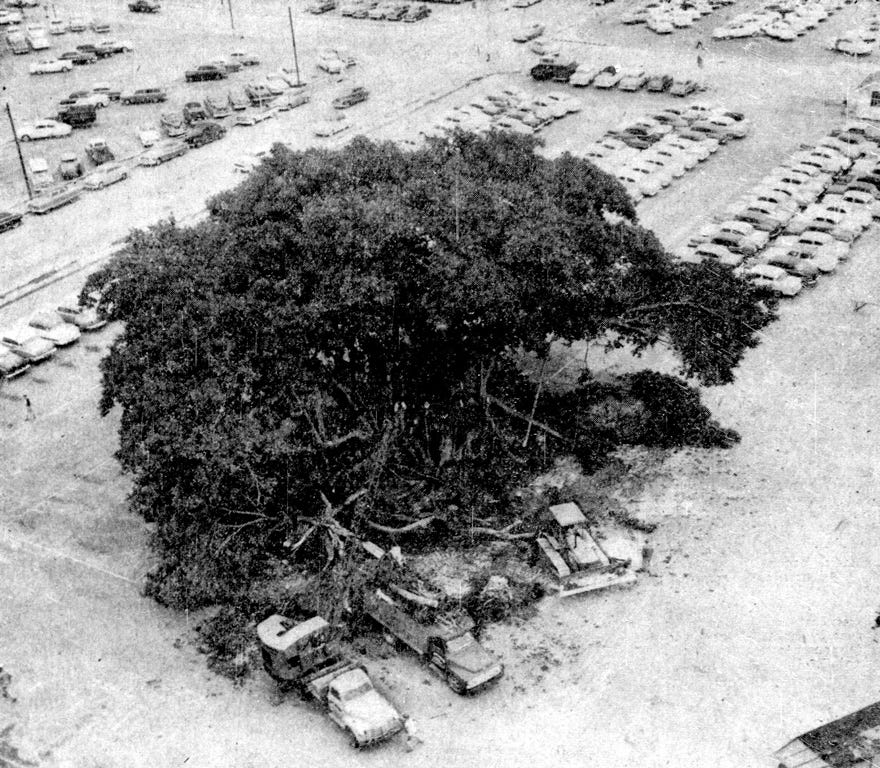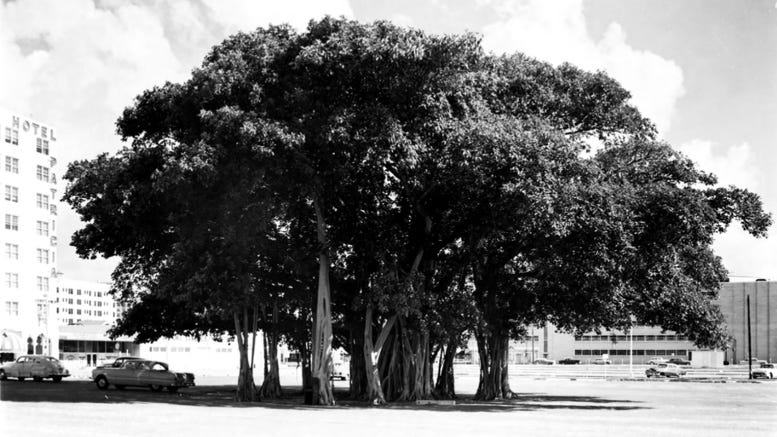Last Remnant of the Royal Palm Gardens
The story of a Banyan tree that was planted in the Royal Palm Gardens in 1896 that lasted more than 20-years after the demolition of the Royal Palm Hotel.
On Saturday, December 10, 1955, the last tree that once stood in the Royal Palm gardens was felled and removed from a parking lot in downtown Miami. Years earlier, the banyan tree was rooted along the west wall of the Royal Palm Hotel dining room extension which overlooked the tropical gardens behind Flagler’s Royal Palm Hotel.
When the hotel was progressively razed from 1928 through the early 1930s, the once beautifully landscaped green space, as well as the footprint of Henry Flagler’s former inn, slowly evolved to a vast sea of surface parking. The rationale behind removing the tree was to provide an additional “6 or 8” parking spaces in an already 338-car lot as downtown Miami was preparing for the construction of the Dupont Plaza Center.
According to a story published in the Miami Herald on Sunday, December 11, 1955, the sentiment from the public for the historic banyan was “woodmen spare that tree”, but sentiment did not change the fate of what occurred on the prior Saturday afternoon. The tree had survived storms, a fire, and the removal of the structure it was planted to shade. When it was toppled by the great hurricane of 1926, workman righted the tree, allowing it to take root and thrive for another three decades. However, the last remnant of the Royal Palm gardens would not survive its removal order in December of 1955.
Planted in 1897 or 1903?
The idea for the Royal Palm gardens was born out of a requirement by Julia Tuttle when she negotiated the donation of half of her land to Henry Flagler. She insisted that Flagler’s hotel would not block her view of Biscayne Bay, requiring Flagler’s men to construct the inn north of the edge of the Miami River leaving space for an expansive backyard for the Royal Palm hotel. This backyard would become a tropical garden for guests to enjoy a scenic stroll from the hotel’s riverside back entrance to the Royal Palm docks.
Flagler hired Henry Coppinger Senior to provide a landscape design and install a diverse set of tropical plants and trees for what would be referred to as the Royal Palm gardens. Born in 1848 in Cork, Ireland, Henry was the son of a horticulturist who kept the grounds of a lord’s estate in that city. Having learned the craft from his father, Coppinger left for America when he was 19 years old to eventually migrate to Miami in 1897 when he was hired by Flagler to be the hotel’s landscape architect.
During his time in South Florida, Henry was also credited with planting the first avocado on the Charles Deering estate in Cutler, popularized Australian pines as a wind break in the early years of Miami Beach, and perfected the first white poinsettia plant. Coppinger was also credited with being the first to introduce a strain of red bougainvillea that he incorporated into the Royal Palm gardens.
While Coppinger was responsible for the design and implementation of the gardens in 1897, it is not clear if the banyan tree removed in 1955 was planted in 1897, or a few years later in 1903. Early photos of the gardens do not appear to include the sapling that would become the grand old banyan seen in the cover photograph of this article.
However, when a dining room extension was added to the back of the hotel in the summer of 1903, it appears some changes were made to the landscape which appear to have included the addition of a young banyan tree near the west wall of the extension. While the reporter covering the removal of the tree in 1955 claimed that it dated to 1897, it is likely that it was actually planted in 1903 during the addition of the dining room.
Demolition of the Royal Palm Hotel
There were several milestones that marked the end of the Royal Palm hotel and surrounding property beginning with the great hurricane of 1926. Prior to 1926, the FEC organization had already considered closing the wood-framed hotel given the obsolescence of the building in relation to newer hotels, but the hurricane inflicted enough damage that its owners decided to close it permanently in the aftermath of the storm.
During the construction of the Brickell Bridge in 1928, the city used eminent domain to acquire the land occupied by the western edge of the hotel requiring the FEC to begin demolition of that part of the structure. By 1930, the Royal Palm Hotel was mostly razed with the exception of the dining room extension that was added in 1903. An aerial photograph of the demolition on October 30, 1932, shows the dining room and the mature banyan tree as two of the last remaining relics of the old hotel.
Banyan Tree in Parking Lot
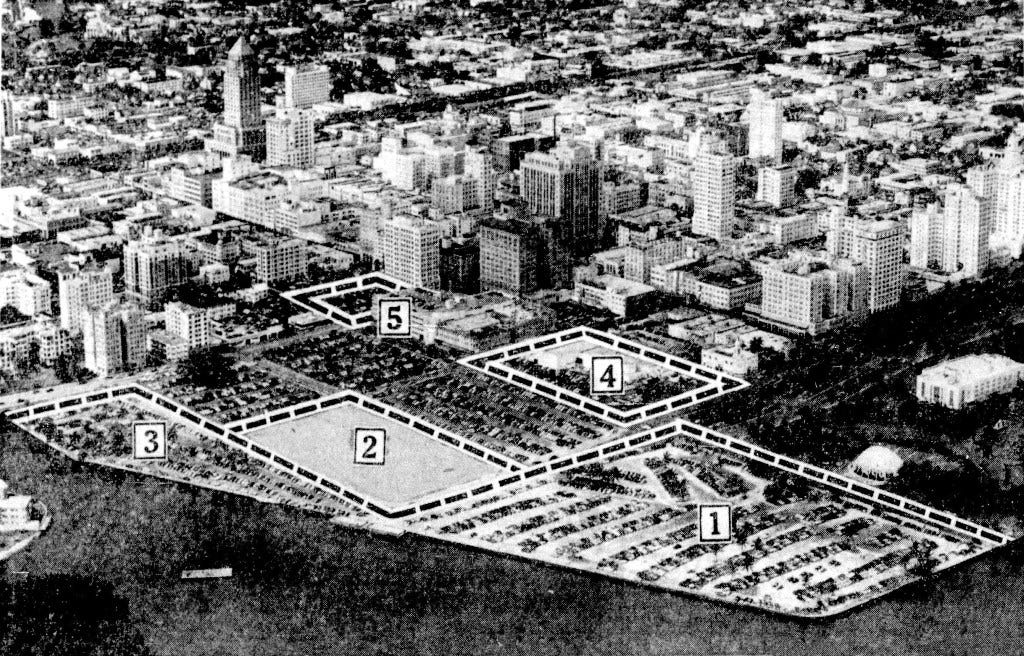
A few years after the photograph, the area once occupied by the Royal Palm hotel and gardens was referred to as Dupont Plaza and consisted primarily of downtown surface parking lots. The plaza stretched from SE Second Street to the Miami River and east toward Bayfront Park.
From the early 1930s to the mid-1950s, the only item remaining from the Royal Palm hotel days was the banyan tree, which served the role of providing shade for a few of the parking spots in the lot between SE Third Street and today’s Biscayne Boulevard Way, where the tree was centered along SE Second Avenue. By 1954, the banyan tree was considered the largest of its kind in South Florida.
When the Dupont Plaza Center complex was announced in 1954, the city felt it needed every possible parking spot it could muster which led to the issuance of a demolition permit for the banyan tree. Although the gain of parking spots was considered nominal, the city felt it was time to remove what stood out as an orphan tree in an expanse of asphalt and concrete.
Removed on a Saturday
Removal of the banyan began on Saturday morning of December 10th and only took a day to fell and remove. While the elimination of the tree was considered incremental progress by the city and builders of the Dupont Plaza structure, to many early Miami residents, it represented the final chapter in the story of the Royal Palm Hotel. Many of the relics from the old hotel were sold at auction during the demolition process, including lighting fixtures, the hotel’s columns, and the contents of the old hostelry, but none of those artifacts remained on the original grounds of the Royal Palm. The banyan tree was the lone exception.
The area that was once an expanse of surface parking has since been developed and now consists of tall condominium and commercial towers. The former location of the banyan tree is now occupied by the Wells Fargo Center building at 333 SE Second Avenue. Specifically, the tree would have been located at the front entrance of the building, which was constructed in 2010 and is currently the ninth tallest building in the city. The reporter for the Miami Herald article on December 11, 1955, summed up the legacy of that banyan tree when they wrote: “it was the sole relic of a glamorous page in Miami’s history.” A page that was unceremoniously turned on a Saturday afternoon in the winter of 1955.
Resources:
Miami Herald: “Picturesque Tropical Gardens Invite Visitors to Gaze on Native Florida”, January 22, 1922.
Miami Herald: “Woodman Spare That Tree”, December 11, 1955.
Images:
Cover: Banyan tree in parking lot on November 28, 1950. Courtesy of Miami-Dade Public Library, Romer Collection.
Figure 1: Royal Palm Gardens in 1903. The banyan sapling is highlighted by black box. Courtesy of U.S. Library of Congress, Detroit Publishing.
Figure 2: Aerial view of downtown Miami on October 30, 1932. Red arrow points to banyan tree. Courtesy of Miami Herald.
Figure 3: Aerial of Dupont Plaza in downtown Miami in 1955 prior to the removal of the banyan tree. Numbers represent locations of planned new buildings. Courtesy of Miami Herald.
Figure 4: Banyan tree being removed on December 10, 1955. Courtesy of Miami Herald.
Figure 5: Closeup of banyan tree in parking lot on November 28, 1950. Courtesy of Miami-Dade Public Library, Romer Collection.


